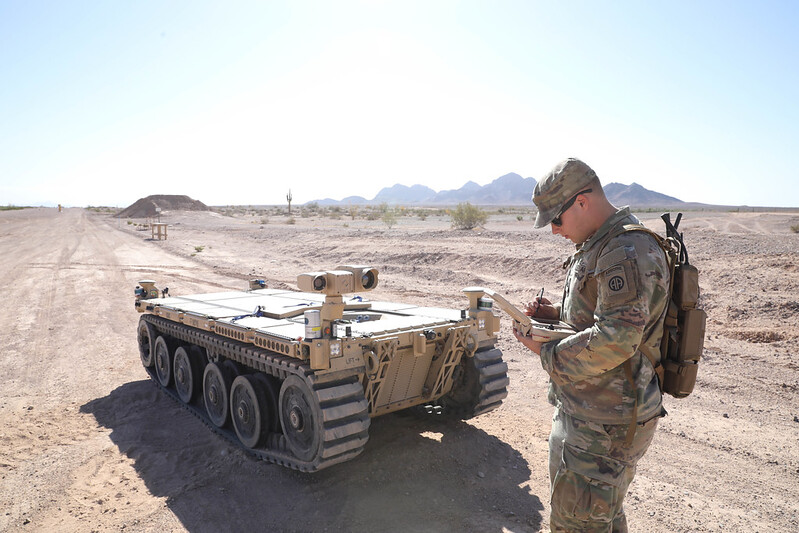

Objective
This is a Direct to Phase II. The purpose of this topic is to develop a self-contained system for autonomous vehicles that can be used to determine when people are around the vehicle and leverage this information to inform the actions of the autonomous system. RCV-L will be next to soldiers and enemy combatants in the operating environment, therefore necessitating a vehicle that can identify when people or objects are too close. Submissions must utilize and integrate a combination of Hardware and Software to inform the platform / operator of personnel approaching or near the platform.
Description
This is a Direct to Phase II. The following are objectives of this topic: provide notice to the platform of unexpected personnel (threats), provide notice to the platform of expected personnel (friendly), provide additional safety controls to protect personnel in close to the vehicle, and develop a system that does not have to be confined to solely body-worn solutions. Currently, the unmanned vehicle operator is responsible for situational awareness of people around the vehicle. It is difficult to have full situational awareness via onboard cameras. Bandwidth limitations restrict video sent to the operator, the operator cannot monitor all video, and the operator’s information may not always be current. Therefore, if successful, the operator and the platform can use sensors and software to recognize people and inhibit the platform from injuring people.
Phase I
This is a direct to Phase II. Please see Phase II for complete instructions on what is necessary to be demonstrated in your Phase II proposal. To demonstrate Phase I success in your Phase II proposal, please utilize commercially available components and pre-existing efforts in your research.
Phase II
This is a direct to Phase II. Please submit a Phase II proposal for this topic, as Phase I efforts are not required. This is an integration effort of commercially available components and pre-existing efforts, rather than being the development of a new technology altogether. There is potential for Phase II efforts to integrate into Surrogate Prototype for testing and data collection; potential for effort to integrate into FSP solution; potential to align to the Software Acquisition Pathway (SWP). Success will be measured through preliminary and Critical Design Reviews; Performance of / improvement in Receiver Operator Characteristic (ROC) Curves; and Accuracy of tracks.
Phase III
Further Phase III instructions will be established in detail in the future. There is potential for integration into future RCV-L platforms dependent on maturity and success of Phase II efforts.
For more information, and to submit your full proposal package, visit the DSIP Portal.

References:
J. E. Naranjo, M. Clavijo, F. Jiménez, O. Gómez, J. L. Rivera and M. Anguita, “Autonomous vehicle for surveillance missions in off-road environment,” 2016 IEEE Intelligent Vehicles Symposium (IV), 2016, pp. 98-103, doi: 10.1109/IVS.2016.7535371.
Objective
This is a Direct to Phase II. The purpose of this topic is to develop a self-contained system for autonomous vehicles that can be used to determine when people are around the vehicle and leverage this information to inform the actions of the autonomous system. RCV-L will be next to soldiers and enemy combatants in the operating environment, therefore necessitating a vehicle that can identify when people or objects are too close. Submissions must utilize and integrate a combination of Hardware and Software to inform the platform / operator of personnel approaching or near the platform.
Description
This is a Direct to Phase II. The following are objectives of this topic: provide notice to the platform of unexpected personnel (threats), provide notice to the platform of expected personnel (friendly), provide additional safety controls to protect personnel in close to the vehicle, and develop a system that does not have to be confined to solely body-worn solutions. Currently, the unmanned vehicle operator is responsible for situational awareness of people around the vehicle. It is difficult to have full situational awareness via onboard cameras. Bandwidth limitations restrict video sent to the operator, the operator cannot monitor all video, and the operator’s information may not always be current. Therefore, if successful, the operator and the platform can use sensors and software to recognize people and inhibit the platform from injuring people.
Phase I
This is a direct to Phase II. Please see Phase II for complete instructions on what is necessary to be demonstrated in your Phase II proposal. To demonstrate Phase I success in your Phase II proposal, please utilize commercially available components and pre-existing efforts in your research.
Phase II
This is a direct to Phase II. Please submit a Phase II proposal for this topic, as Phase I efforts are not required. This is an integration effort of commercially available components and pre-existing efforts, rather than being the development of a new technology altogether. There is potential for Phase II efforts to integrate into Surrogate Prototype for testing and data collection; potential for effort to integrate into FSP solution; potential to align to the Software Acquisition Pathway (SWP). Success will be measured through preliminary and Critical Design Reviews; Performance of / improvement in Receiver Operator Characteristic (ROC) Curves; and Accuracy of tracks.
Phase III
Further Phase III instructions will be established in detail in the future. There is potential for integration into future RCV-L platforms dependent on maturity and success of Phase II efforts.
For more information, and to submit your full proposal package, visit the DSIP Portal.
References:
J. E. Naranjo, M. Clavijo, F. Jiménez, O. Gómez, J. L. Rivera and M. Anguita, “Autonomous vehicle for surveillance missions in off-road environment,” 2016 IEEE Intelligent Vehicles Symposium (IV), 2016, pp. 98-103, doi: 10.1109/IVS.2016.7535371.
